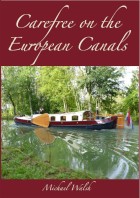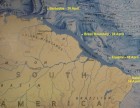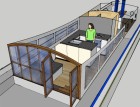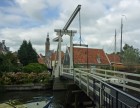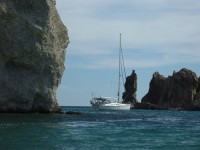Sequitur
Michael & Edi have headed out on a slow, thorough exploration of the globe.
| Vessel Name: | Sequitur and Zonder Zorg |
| Vessel Make/Model: | 2007 Hunter 49 and 1908 Wildschut Skûtsje |
| Hailing Port: | Vancouver, Canada |
| Crew: | Michael Walsh & Edi Gelin |
| About: | For our current location click, on Map & Tracking, then on the Google Earth logo. |
| Extra: | Follow us on Twitter: Follow @YachtSequitur |
| Social: |
13 January 2014
Another New Book Released
I am delighted to announce that my new book: Carefree on the European Canals is now in print and is available on Amazon.com, Amazon.ca [...]
26 April 2013
New Book Released
The proof copy of my new book arrived by courier today. I have approved it and it is now listed on Amazon for pre-order, with a publication date of 30 April. It is a rather large book at 680 pages in an 8.5 by 11 inch format with 315,000 words illustrated by over 2400 colour photos, charts and maps. [...]
24 April 2013
One Year Out of Brazil
One year ago today we sailed Sequitur out of Brazil after enduring more than six weeks in the least-friendly country that we had experienced during our three-year voyage. In the early evening of 24 April 2012 we crossed the line on the chart dividing Brazil from French Guyana and breathed a huge sigh [...]
27 October 2012 | Harlingen, Friesland
Planing a Metamorphosis
We have added a new post to the Zonder Zorg blog at: Planing a Metamorphosis.
29 September 2012 | Sneek, Netherlands
Onward to Friesland
We have arrived in Friesland and have added a new post to the skûtsje's blog at: Onward to Friesland
19 September 2012 | Hoorn, Netherlands
North From Aalsmeer
We have moved northward from Aalsmeer and I have added two new posts: Heading North From Aalsmeer and North From Amsterdam
13 September 2012 | Aalsmeer, Netherlands
Taking Possession
We are back in the Netherlands, and I have added some new posts to the ZonderZorg blog at: Taking Possession and Settling-In and Making Plans
20 August 2012 | Sequitur: St Augustine, USA - Michael & Edi: Vancouver, Canada - Nieuwe Zorg: Aalsmeer, Netherlands
Added a New Website
We have added a new website: Skûtsje ZonderZorg. Zonder zorg in Dutch means without worry. Our intention with the site is to provide a place to share some of the history, geography and culture of the skûtsje as we discover it. We will also use this place to document [...]
11 August 2012 | Sequitur: St Augustine, USA - Michael & Edi: Vancouver, Canada - Nieuwe Zorg: Aalsmeer, Netherlands
Still More Skûtsje History
We continued to attempt to track-down Douwe Albert Visser, who was the owner of Nieuwe Zorg in 1941 when she was re-registered. One of the problems we repeatedly encountered in our online searches was the effect of currently having Albert Visser and two Douwe Vissers as very competitive skûtsje racers, [...]
10 August 2012 | Sequitur: St Augustine, USA - Michael & Edi: Vancouver, Canada - Nieuwe Zorg: Aalsmeer, Netherlands
Some More Skûtsje History
While I was researching the history of Nieuwe Zorg, I finally found her first registration details obscured by an apparent typographical error in a transcribed online spreadsheet. She was listed as having been built in 1901 instead of 1908. I emailed the webmaster of the [...]
Welcome to Chile

Mid-afternoon on Boxing Day an Armada inflatable came alongside, and a lieutenant in crisp whites asked permission to come aboard. We welcomed him into the cockpit while his boatmen remained in the launch. He told us that we will be visited by officers from Migracion, Sanidad, Aduana and the Armada the next morning around 1000. He was very courteous and spoke excellent English, and after his brief welcome, he departed. What a dramatic change from our Peruvian welcome!

Shortly after 1000 on Monday an Armada inflatable came alongside and we welcomed five officers onboard and seated them at the cockpit table. The health and sanitation officer inspected below for compliance with agricultural and sanitation regulations. We easily passed. After having paid over S/3000 for sanitario inspections in Peru without an inspector ever having visited Sequitur, this was a refreshing change. For just short of an hour the officers examined our papers and documents, and copied data from them, and through the entire process we carried-on a lively and jovial conversation. Without the conversation, the process would have likely taken only half as long, but both they and we were thoroughly enjoying the interchange.

The Sub-Lieutenant in charge of the party told us we were now officially cleared-in, but that we needed to go to the Harbour Master's office to complete the process and pay the appropriate fees. He pointed out the building as the yellow one near the floats of the yacht club, and then they departed.

I struck the quarantine flag and hoisted the Chilean colours and we were officially in Chile, and without any hassle.

We lowered the dinghy and mounted the motor, finding it much easier this time than it was on our first attempt. We headed in to the marina and secured to a very run-down float with sun-scorched plywood and rusted-out mooring cleats.
We were welcomed by one of the men who had come out on Christmas morning to offer us moorage at the club floats. He showed us the intended slip, which was in slightly better repair than the one on which we had left the dinghy. I asked the depth and was told about 2 metres. In our laden state, we require 2.2 metres, to which he replied there were no rocks and it was a very soft bottom. I reminded him of our wrapped propeller and need of a diver. He said he would organize one.

We headed over to the office of Gobernacion Maritima, the harbour master and met again young Sub-Lieutenant, Victor Caceres who had done our clearance aboard. Very friendly staff copied data from our ship's papers and completed some forms, then told us to come back on Wednesday, adding that the paperwork would probably be back from Santiago on Tuesday, but in case it wasn't, why waste a trip. How refreshing!

Back at the yacht club we were introduced to Abdul, the diver. He loaded his gear into the dinghy and we headed back out to Sequitur in the anchorage. In less than five minutes of free-diving Abdul had cut-away the fouling lines and inspected the propeller, insuring the blades feathered and un-feathered easily. I took him back to the yacht club floats and paid him 25,000 Pesos, about CA$52.
On our way in he pointed-out the locations of shoals and rocks to avoid and some leading marks to use in navigating the narrow, shallow channel into the marina. Passage for us was only possible at high tide, which would give us a quarter metre or so under the keel. The next daylight high tide was at 1532 on Tuesday, so I organized with the yacht club to come in then.

At 1523 on Tuesday we weighed and proceeded in toward the marina. I left the anchor a-cockbill and stationed Edi on the foredeck to prepare to let-go the anchor on my signal. The intention was to drop the anchor, swing around and back-down on it to a Mediterranean mooring on the float with a 3-metre-long finger to our starboard. It went perfectly. With the offset of the snubber attached to the anchor chain from a side cleat, our lead to the anchor was square to the stern and we nestled-in very comfortably balanced between stern lines, springs and anchor. We were in a slip designed for a very small boat; in fact, our neighbour across the finger was no more than seven metres in length, and he looked too big for the slip.

We headed ashore in search of fresh produce. Our Lonely Planet guide showed Supermercado Rossi about a kilometre away in the centre of the old town. We walked into a scene from the Old West; balloon-framed wooden buildings with false facades, ornate door and window frames, lavish trim and very aged bright paint.

Some of the buildings on the periphery of the old town seemed beyond hope of restoration, and were it not for the very arid climate, they would have rotted away many decades ago.

And then we came to Plaza Prat, which looked to us like an architect's rendering complete with small people posing. Ranged around its periphery were some very well-restored classic buildings in a combination of Georgian and Spanish Colonial architecture.

The theatre was particularly impressive, and appears to have been recently restored.

Leading away to the south from the plaza is Boulevard Baquedano, which was the nitrate aristocrats flaunted their power and wealth with lavish homes. Built between 1820 and 1920, many of the imposing houses along the very broad boulevard were constructed from Douglas from British Columbia, Canada.

Covered observation decks seem to have been a standard feature of the homes, and many along the boulevard have been wonderfully restored and there is a very evident pride in the heritage.
We eventually made it to the supermarket and were sorely disappointed. It was without doubt the worst we have seen since the central Baja coast. The produce was dismal; there was a very limited and poor selection of low quality and culls at high prices. Our first impression was that we were in the slums, though the other stores in the neighbourhood were mid-to-upscale. We next thought that there must be a huge fresh produce market nearby. We bought some green peppers, tomatoes and a piece of beef loin plus a couple of bottles of very well priced Chilean wine and went back to Sequitur. For dinner I prepared a lomo soltado in memory of Peru.

Late morning on Wednesday the 29th we caught a collectivo to Zofri for 1000 Pesos, just over $2. Zofri is the largest zona franca, or duty-free zone in South America. It was set-up in 1975 and now encompasses over 240 hectares of shops and warehouses supplying consumers and distributors in northern Chile, southern Peru, Bolivia, Paraguay, Brazil and northern Argentina.

There are over 500 retail shops, with many of these being dollar-store-type outlets. There is also a very large section of upscale brand-name stores, consumer electronics outlets, major and minor appliance stores and a huge auto mall. We bought a digital clock for our master cabin, a strap wrench for Sequitur's filters and a large piece of pork tenderloin for our dinner.

As Edi was preparing pancakes for breakfast on Thursday morning, there was a knock on the hull. I answered it to learn that another boat was coming into the slip beside us, and that we needed to move our port bow line from the opposite finger. I moved the line to a steep lead aft and watched as Blue Dame, a Jeanneau 49 DS from Hallevisstrand, Sweden turned in front of us and ran aground five metres from our bows.

Blue Dame's crew scrambled to let-go their anchor and get lines to the staff on the floats, and I checked clearance with our bow, and there was nothing else for us to do. We sat in the cockpit eating pancakes with Grand Marnier and maple syrup. The tide was just beginning to rise from its low, and we figured that they should float free in three or four hours, and there was nothing anyone could do to assist.

After a wonderful breakfast with front-row seats on the action, we went ashore and walked around the waterfront to the street-side fish stalls. We chose the busiest fishmonger and picked a nice-looking mahi-mahi weighing just over 3.25 kilos.

We agreed when he suggested it be cut to pan-fry size, and watched as he quickly and expertly skinned, filleted, and butterfly-ed the fish for us. The cost was 3900 Pesos, about $8.30 for four double servings plus a soup from the backbone.

We dropped the fish in one of Sequitur's fridges and caught a collectivo up into the hills on the eastern edge of the city. We were heading to Agro, the local market, which has hundreds of stalls and stands selling fruit and vegetables, meats, cheeses, groceries and general merchandise. It sprawls across an area of about six city blocks in a collection of buildings and shelters.
In the first produce building we came to we filled our cooler bag with lovely fresh fruit and vegetables and then explored the remainder of the huge complex. We could find only one bakery, and from it we bought half-a-dozen large rolls. We went back to the main street and tried to catch a collectivo back to the marina. For more than twenty minutes we tried, but kept getting "our" taxi commandeered by locals who knew the ropes. Since it was downhill, we decided to start walking. We could see the port about four or five kilometres away, and the slope was gentle. It was early afternoon without a cloud in the sky, the sun was only two degrees from our latitude, but it was surprisingly temperate, with the dry air and the cooling influence off the South Pacific.

After a couple of kilometres we came to a major cross-street, and a couple of blocks along it we saw a huge shopping centre with a Sodimac, which we recognized from Peru. In Sodimac we picked-up two 220v 32 amp electrical plugs so I can make-up adapters for the Chilean shore power.
A block further along we found a huge Lider supermarket. Among other things we bought a kilo of butter, a kilo of mushrooms, assorted ham and salami and a dozen bottles of wine at ridiculously low prices compared to those we have seen so far. We also bought a bottle of Chilean Pisco to try.

Outside we joined the line waiting for a taxi, and in about ten minutes, it was our turn. We tried to describe our destination to the driver, but he couldn't comprehend "Puerto", "Marina", "Club de Yates", "Capitan de Puerto", "Gobernacion Maritima" nor any other name we could conceive to convey to him our goal. He searched the crowd for someone who spoke better English, and she seemed as lost as he was. Lost, that is until I hauled-out my camera and showed them a photo of our destination. They both knew it immediately, and knew it as everything we had been calling it. It seems they didn't think any gringo would want to go there with groceries.

On Thursday evening we enjoyed some of the very fresh mahi-mahi butter-fried and accompanied by rice and a butter-sweat of a julienne of carrots, red and green peppers and small white onions. The mahi-mahi was pronounced well worthy of at least two more for the freezer.

After dinner we tried our three different Piscos: a Pisco Puro from Vista Alegre and a Pisco Mosto Verde Torontel Don Santiago, both from Peru. From Chile we tried a simple supermarket brand aged co-op produced Pisco, Alto de Carmen. Possibly because we love Cognac, Armagnac, single malt Scotch and other fine aged spirits, the Chilean Pisco won hands down. The others were harsh, raw spirits by comparison when we went back to them. They certainly need help, which is why the mixed-drink, Pisco sour is popular.

We spent a quiet day on the 31st, taking a walk through the old parts of town and sitting aboard soaking in the scene. A group on Inca terns decided to pose for us on the pulpit of our neighbour's boat.

Our New Year's Eve was celebrated quietly on board with a diner of the last of our jumbo prawns, which we had bought through Frano in La Punta. We spent the evening reminiscing about all of the wonderful experiences we have enjoyed during the past year, enjoying the stillness of our small space, and thanking Whomever for our continuing good health. We are so blessed to be doing what we are doing; it would be wonderful if everyone could feel as fulfilled. Happy New Year.

